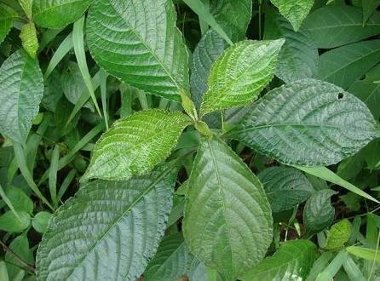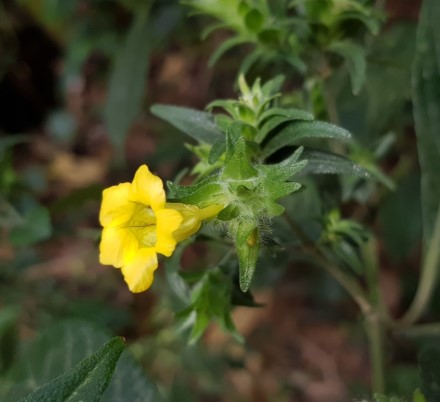Contents:
Common Names | Parts Usually Used | Plant(s) & Culture | Where Found | Medicinal Properties | Biochemical Information
Uses | Formulas or Dosages | Nutrient Content | How Sold | Warning | Resource Links
Scientific Names

- Strobilanthes crispus
- Cericocalyx crispus
- Strobilanthes crispa
- Saricocalyx crispus
- Acanthaceae family
Common Names
- Bayam karang (Malaysia)
- Black Face General
- Enyoh kelo (Java)
- Hei mian jiang jun (Chinese)
- Jin batu (Malaysia)
- Kecibeling (Java)
- Kejibeling (Java)
- Ngokilo (Java)
- Pecah beling (Malaysia)
- Pecah kaca (Malaysia)
- Picah beling (Jakarta)
- Yellow strobilanthus
Parts Usually Used
Leaves
Back to Top
Description of Plant(s) and Culture
Strobilanthes crispus is a flowering shrub that grows up to 2 meters tall, usually found wild near riverbanks, abandoned fields or in scrublands. The plant’s flowers are yellow.
Back to Top
Where Found
The Black Face General plant is native to Malaysia, Indonesia and Madagascar.
Back to Top
Medicinal Properties
The Black Face General plant posesses anticancer, antioxidant, antiangiogenic, antimicrobial, anti-HIV, antilytic, laxative, diuretic, free radical scavenging, wound healing, antidiabetic, hypolipidemic and antiulcerogenic properties.
According to AlliedAcademies.org: A number of studies demonstrated that S. crispus crude extracts are cytotoxic to cancer cell lines. We showed that a bioactive sub-fraction of S. crispus leaves (SCS) induced cell cycle arrest and apoptosis of human breast cancer cell lines. The mechanism involves perturbation of mitochondrial function and modulation of cell cycle regulatory proteins and apoptotic signaling molecules. SCS acted synergistically with the antiestrogen, Tamoxifen, suggesting the potential to achieve the desired cytotoxic effect in cancer treatment at lower drug doses with the potential for reduction in side effects or toxicity of the drug on non-cancerous cells. SCS also displayed potent anticancer effects in vivo. SCS reduced tumour volume and tumour multiplicity in rats bearing N-methyl nitrosourea-induced mammary tumors. These were accompanied by modulation of the expression of cyclins and cyclin-dependent kinases as well as various signaling molecules of both the intrinsic and extrinsic pathways. Interestingly, SCS is also capable of activating the immune system in vivo that may contribute to the anticancer effects of SCS. Importantly, hematological and clinical biochemistry profiles indicated that SCS is relatively safe, further lending support for the therapeutic potential of SCS.
Biochemical Information

This plant contains caffeine, polyphenols, catechins, flavonoids, alkaloids and tannins. Specifically, leaf extracts contain phenolic acids (p-hydroxybenzoic acid, p-coumaric acid, gallic acid, vanillic acid, gentinic acid, caffeic acid, ferulic acid, trans-cinnamic acid, syryngic acid, chlorogenic acid) and flavonoids (apigenin, rutin, catechin, quercetin, naringenin, kaempferol)
Back to Top
Uses
In West Malaysia, the fresh leaves are chewed and swallowed to increase the immune system.
The heated leaves are applied to the hips to treat kidney stones in Malaysia.
A tea or infusion made from the leaves is used traditionally to treat cancer and diabetes.
A poultice on the chest is used for treatment of cough or ague in children.
This plant is also often used as a laxative.
Formulas or Dosages
Crushed, dried leaves are simmered in hot water to create a tea. It is often sweetened with a bit of sugar.
Fresh leaves are crushed to a puree or juiced and consumed.
The leaves can be boiled to create an infusion.
Nutrient Content
The plant contains significant amounts of minerals and vitamins C, B1 and B2.
How Sold
Capsules, teas, leaf powder
Back to Top
Warning
It is not advisable to use this plant while pregnant.
Back to Top
Resource Links
Recent Studies Show Seven Herbs Help Stop Cancer Growth
Futurity.org: These Medicinal Plants Put Brakes on Cancer Growth
National University of Singapore: Anti-cancer properties uncovered in plants
Wikipedia: Strobilanthes crispa
ResearchGate: Strobilanthes crispus
ResearchGate: Strobilanthes crispus
Anticancer effects of Strobilanthes crispus in experimental breast cancer
Malaysian Herbal Monograph: Pecah Beling Leaves
